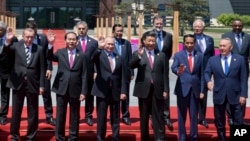Prime Minister Hun Sen was in Beijing this week for a meeting on China’s “Belt and Road” initiative, which analysts said could bring significant benefits to Cambodia.
The multi-trillion-dollar scheme proposed by Chinese premier Xi Jinping in 2013 aims to promote economic integration across Eurasia by investing in a “Silk Road Economic Belt” and “Maritime Silk Road”, comprising transnational economic corridors and new trade arrangements.
Joachim Von Amsberg, a vice president at the Asian Infrastructure Investment Bank, which will fund the scheme, told the World Economic Forum in East Asia, held in Phnom Penh last week, that the increased integration offered by Xi’s initiative was being widely welcomed in Asia.
“The infrastructure is quite a central part of development strategy that benefits in particular countries like Cambodia,” he said.
He added that Cambodia would need to develop policies to ensure that the plans can be implemented and infrastructure brought up to scratch.
“In energy, for example, providing reliable and sustainable energy for all,” he added. “Similarly, transport that allows trade across the region, but also allows all people access to markets, people in rural areas could access school and health care.”
According to Asian Development Bank figures, the Association of Southeast Asian Nations -- a 10-nation bloc including Cambodia -- will need some $26 billion in investment by 2030 to meet regional infrastructure demands.
Mark Rathbone of PricewaterhouseCoopers said better regulations were needed in Cambodia to encourage investment in infrastructure from the private sector.
“Of course the project, Belt and Road, would be able to help the government talking to the Chinese government, Japanese government, Korean government, Singaporean government, Malaysian and Thai government,” Rathbone said, “All of those who might want to invest in your country through all the types of relationships.”
Chheang Vannarith, chairman of the Cambodian Institute for Strategic Studies, said in joining the Belt and Road Initiative Cambodia must also pay close attention to the social and environmental impact of development.
“The risk in infrastructure development comes if we make fast development without the proper study on the environmental and social harm,” he said.







